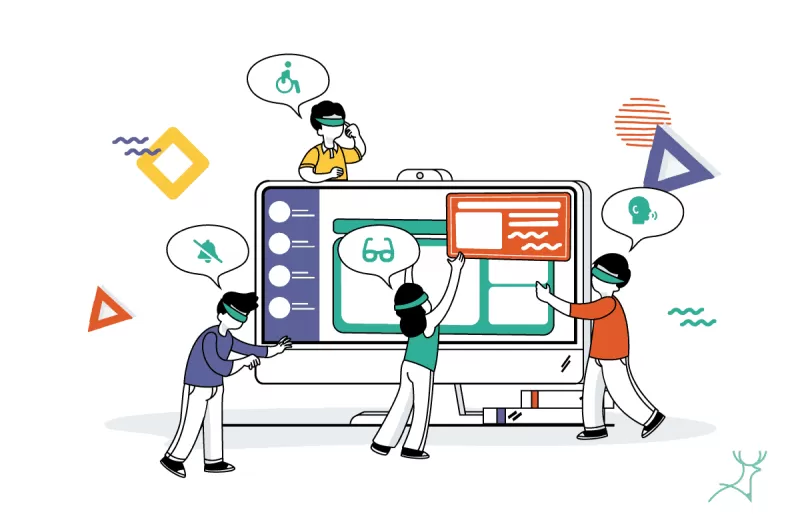
ensuring that your website is accessible to all users is not just a matter of good practice—it's a necessity. Making your website accessible means that everyone, including individuals with disabilities, can use your site without barriers. This includes people with visual, auditory, cognitive, and motor impairments. In this comprehensive guide, we’ll explore how to make a website accessible for all users, discussing the importance of web accessibility, key principles to follow, and practical steps you can take to ensure your website is inclusive and compliant with global standards.
Before diving into the specifics of how to make a website accessible for all users, it's essential to understand why web accessibility matters. According to the World Health Organization (WHO), over 1 billion people, or approximately 15% of the global population, live with some form of disability. For these individuals, the internet can be both a vital resource and a challenging space, depending on how websites are designed.
Ensuring web accessibility is not only about meeting legal requirements, such as those outlined in the Americans with Disabilities Act (ADA) or the Web Content Accessibility Guidelines (WCAG), but also about creating an inclusive online environment where everyone has equal access to information, services, and opportunities. Moreover, an accessible website can enhance your brand's reputation, increase user engagement, and improve search engine optimization (SEO).
Web accessibility refers to the practice of designing websites in a way that enables people of all abilities and disabilities to use them. This includes the ability to perceive, understand, navigate, and interact with the web. An accessible website is one that can be used effectively by people with disabilities, whether they are using assistive technologies like screen readers or require alternative means of interaction.
The Web Content Accessibility Guidelines (WCAG) provide a set of standards and best practices for making web content more accessible. These guidelines are organized around four key principles:
Making your website accessible requires careful planning and attention to detail. Below, we’ll cover practical steps on how to make a website accessible for all users, addressing various aspects of design, content, and functionality.
Semantic HTML refers to using HTML tags that accurately describe the content they enclose. For example, using <header>, <nav>, <article>, and <footer> tags helps to define the structure of your page. This practice not only improves accessibility by making it easier for screen readers to interpret the content, but it also enhances SEO by giving search engines better context about your content.
<h1>, <h2>, <h3>, etc.) in a hierarchical order to structure your content.<ul> and <ol> tags for lists and <table> tags for tabular data, with appropriate <th> and <td> tags.<label> tag.Images, videos, and other non-text content can pose accessibility challenges. Providing text alternatives ensures that everyone can access the information these elements convey.
alt attributes to provide descriptive text for images. This is especially important for functional images, such as buttons or links.Not all users can or prefer to use a mouse. Ensuring that your website can be navigated using only a keyboard is crucial for accessibility.
Color contrast plays a significant role in readability, especially for users with visual impairments such as color blindness. Ensuring sufficient contrast between text and background colors can improve the accessibility of your site.
Forms are a common source of accessibility issues. Making forms accessible ensures that all users can complete and submit them without difficulties.
<label> tags for every form input and associate them correctly using the for attribute.Clear, concise, and well-structured content is easier for everyone to understand. This is particularly important for users with cognitive disabilities.
Assistive technologies, such as screen readers, help users with disabilities navigate and interact with websites. Ensuring compatibility with these tools is essential for accessibility.
aria-label for providing additional context to screen readers.Making your website accessible is an ongoing process that requires regular testing and validation. Here’s how to ensure your site remains accessible as it evolves:
Automated tools can help you identify common accessibility issues on your website. Tools like Axe, WAVE, and Lighthouse can scan your website and provide a report on areas that need improvement.
While automated tools are valuable, they can’t catch every accessibility issue. Manual testing allows you to experience your website as a user with disabilities might, helping you identify problems that automated tools miss.
Incorporating feedback from users with disabilities is one of the most effective ways to improve your website’s accessibility. Consider involving users in the testing process to gather insights on how to make your website more inclusive.
In many countries, web accessibility is not just a best practice—it's a legal requirement. Understanding the legal framework surrounding web accessibility can help you avoid potential lawsuits and ensure your website is compliant with regulations.
Different countries have varying laws and regulations related to web accessibility. In the United States, for example, the Americans with Disabilities Act (ADA) requires that websites be accessible to individuals with disabilities. Similarly, the European Union’s Web Accessibility Directive mandates that public sector websites meet accessibility standards.
Beyond legal obligations, there’s a strong ethical case for making your website accessible. By creating an inclusive online environment, you are ensuring that everyone, regardless of their abilities, has equal access to your content and services. This commitment to inclusivity can enhance your brand’s reputation and foster customer loyalty.
Making your website accessible to all users is not just about compliance; it's about creating a better user experience for everyone. By following the principles and practices outlined in this guide, you can ensure that your website is inclusive, user-friendly, and compliant with global accessibility standards.
Whether you’re starting from scratch or looking to improve an existing site, Sympaweb is the best web design company to help you achieve your accessibility goals. With expertise in creating websites that are both visually stunning and fully accessible, Sympaweb can help you build a website that meets the needs of all users, ensuring that your online presence is inclusive and welcoming to everyone.